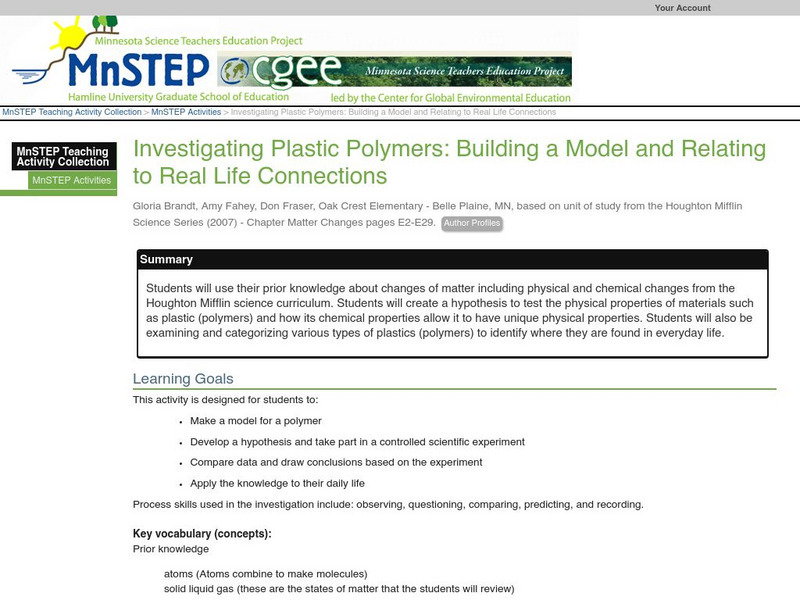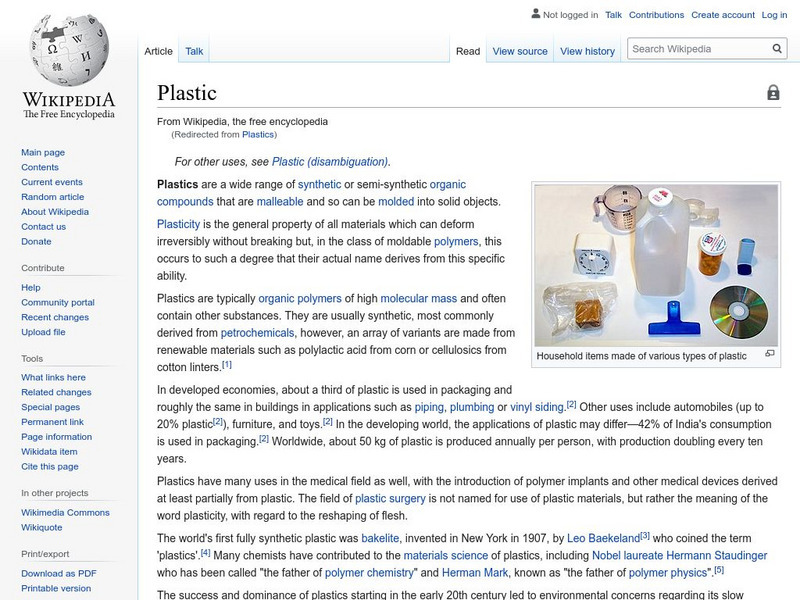Science Education Resource Center at Carleton College
Serc: Investigating Plastic Polymers: Building a Model
Students will use their prior knowledge about changes of matter including physical and chemical changes from the Houghton Mifflin science curriculum. Students will create a hypothesis to test the physical properties of materials such as...
Science Education Resource Center at Carleton College
Serc: Mn Step: Where in the World Can I Find Plastic Polymers. Why Are They Used?
An investigation of where plastic polymers can be found in everyday life. After identifying them, students test them to learn about their properties, then try some online activities.
Science Education Resource Center at Carleton College
Serc: Plastic Polymers: Investigating Their Flexibility
Young scholars will use their prior knowledge about changes of matter to develop a hypothesis to test the physical properties of materials such as plastic (polymers) and how its chemical properties allow it to have unique physical...
TeachEngineering
Teach Engineering: Close Encounters of the Polymer Kind
Students explore the basic characteristics of polymers through the introduction of two polymer categories: thermoplastics and thermosets.
Concord Consortium
Concord Consortium: Stem Resources: Plastic Forces
This simple interactive tool lets students explore what happens to the long molecular chains in a plastic polymer material when forces of varying intensity are exerted on it.
Science Education Resource Center at Carleton College
Serc: Polymers & Plastics: Classification & Models
Young scholars will use their prior knowledge about changes of matter including physical and chemical changes to examine and categorize various types of plastics (polymers). They will identify how their chemical properties allow them to...
TeachEngineering
Teach Engineering: Bridging to Polymers: Thermoset Lab
Students act as engineers to learn about the strengths of various epoxy-amine mixtures, and observe the unique characteristics of different mixtures of epoxies and hardeners. Student groups make and optimize thermosets by combining two...
Other
American Chemistry Council: History of Polymer and Plastics for Students
This resource presents a brief guide introduces the history, structure, and characteristics of plastics and polymers.
Practical Action
Practical Action: Plastics Challenge
This is a challenge for students to develop solutions to the problems caused by plastic waste globally. They will learn about how plastic waste impacts people around the world, the different types of plastic, how they are each used, how...
Other
American Chemistry Council: History of Polymers & Plastics for Teachers
This resource presents a teacher guide that offers information on the history, structure, characteristics, forms, and common uses of plastics and polymers.
TED Talks
Ted: Ted Ed: From Dna to Silly Putty, the Diverse World of Polymers
Polymers occur both naturally- our DNA is a polymer- and synthetically, like plastic, Silly Putty, and styrofoam. Jan Mattingly explains how polymers have changed our world. [4:59]
Wikimedia
Wikipedia: Plastic
Wikipedia offers all of the basic information one would need about the topic of plastic. Includes hyperlinked table of contents for easy site navigation.
Maryland Science Center
Maryland Science Center: Milk Plastic [Pdf]
A simple experiment to create a chemical reaction between milk and vinegar, with the product being a type of plastic.
Science Buddies
Science Buddies: Turn Milk Into Plastic!
In this hands-on lesson plan, middle schoolers will conduct a simple milk-transforming experiment to explore how plastics can be derived from a natural resource such as milk.
McREL International
Mc Rel: Glue Polymer (Whelmer #15 Learning Activity)
An easy to do activity that investigates the basic principles behind chemical bonding. The activity is written in lesson plan format that meets NSES standards.
Math Science Nucleus
Math/science Nucleus: Polymer Storybook
This animation discusses polymers and the properties of polymers in a storybook format. The story covers polymers both plastic and natural, and provides interesting information.
Other
American Chemistry Council: Plastics: Basics: Polymer Definition and Properties
This resource provides information about what polymers are and their properties.
Science Education Resource Center at Carleton College
Serc: Mn Step: Shrinky Dink Chemistry
In this lesson, students first learn about thermoplastics, and about polystyrene in particular, which is a #6 plastic. They will then heat different #6 plastics to create shrinky dinks. As they are heated, they shrink, which is a...
Other
American Plastics Council: The History of Plastics
This site from the American Plastics Council provides a brief history of all major developments of fibers and plastics including the early invention of rayon. Very interesting and informative, it also includes a timeline for easier...
Science is Fun
Science Is Fun: Gluep Solid or Liquid?
In this experiment, students create a polymer substance called Gluep, then investigate its properties. Includes a detailed explanation of how the polymer molecules bond together to form the plastic.
Massachusetts Institute of Technology
Mit: Inventor of the Week: Leo Baekeland
Use this site to learn about how Leo Baekeland invented plastic, and how this simple invention resulted in a "plastic revolution."
Other
Libros Vivos: Los Plasticos
Plastics are obtained by polymerization of compounds derived from petroleum and natural gas. Learn about the different plastics and about the different process of fabrication in this site. You will find a lot of illustrations and...
Science Struck
Science Struck: Ldpe Plastic
LDPE stands for low-density polyethylene. This resource describes its structure, physical and chemical properties, resistance to various chemicals, advantages and disadvantages, uses, its BPA-free status, and the issue of recycling LDPE...
American Chemical Society
American Chemical Society: The Bakelizer [Pdf]
Find out all you want to know about the revolutionary development of Bakelite, the first plastic created entirely from chemicals. Included is a biography of the inventor of Bakelite, Leo Baekeland.












![Maryland Science Center: Milk Plastic [Pdf] Activity Maryland Science Center: Milk Plastic [Pdf] Activity](https://static.lp.lexp.cloud/images/attachment_defaults/resource/large/FPO-knovation.png)







![American Chemical Society: The Bakelizer [Pdf] Handout American Chemical Society: The Bakelizer [Pdf] Handout](http://lessonplanet.com/content/resources/thumbnails/456091/large/bwluav9tywdpy2symdizmdeyny0xmte3mdk4lwcwy3uxni5qcgc.jpg?1674856933)